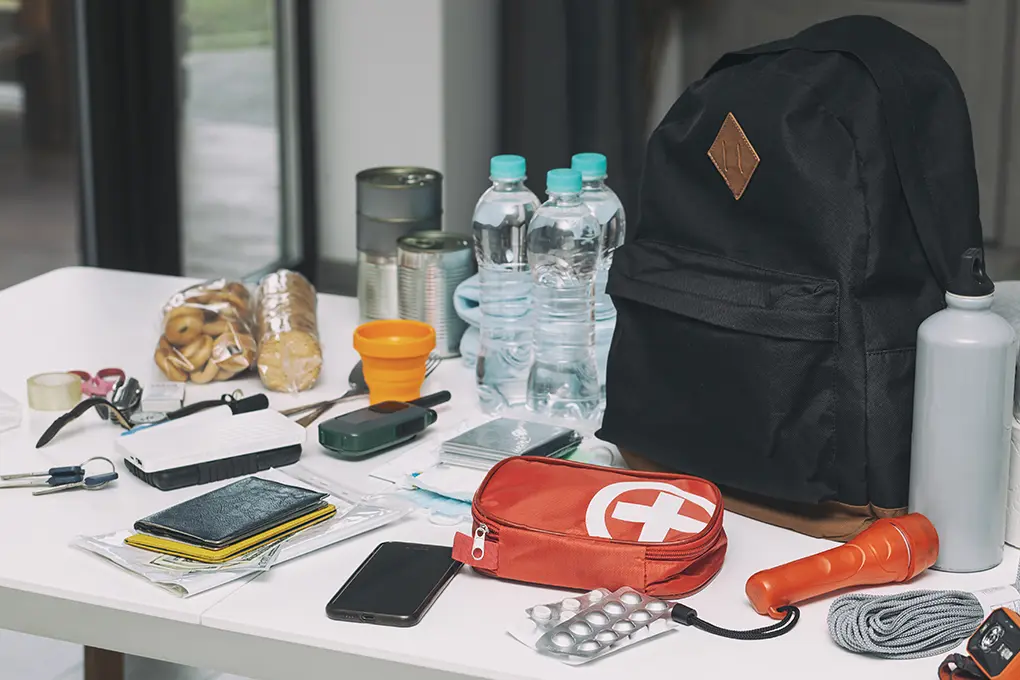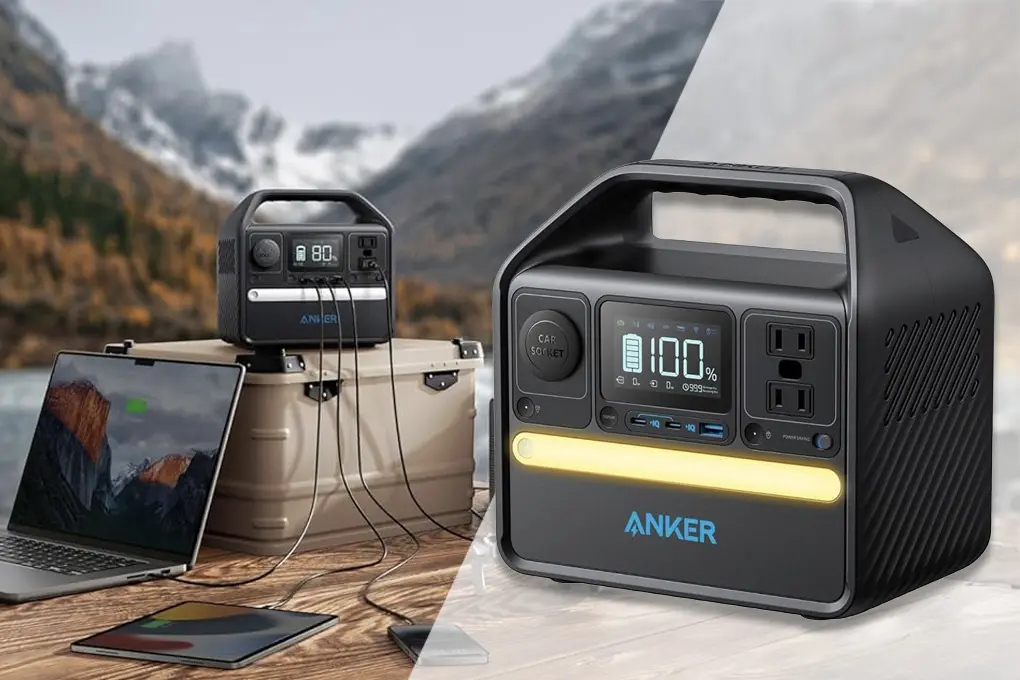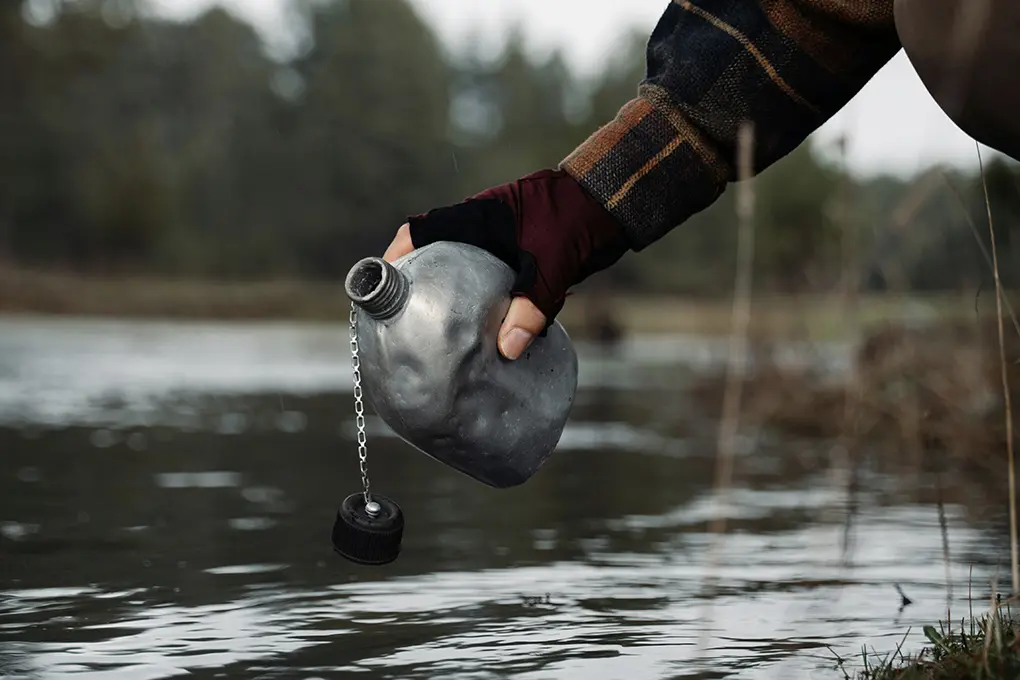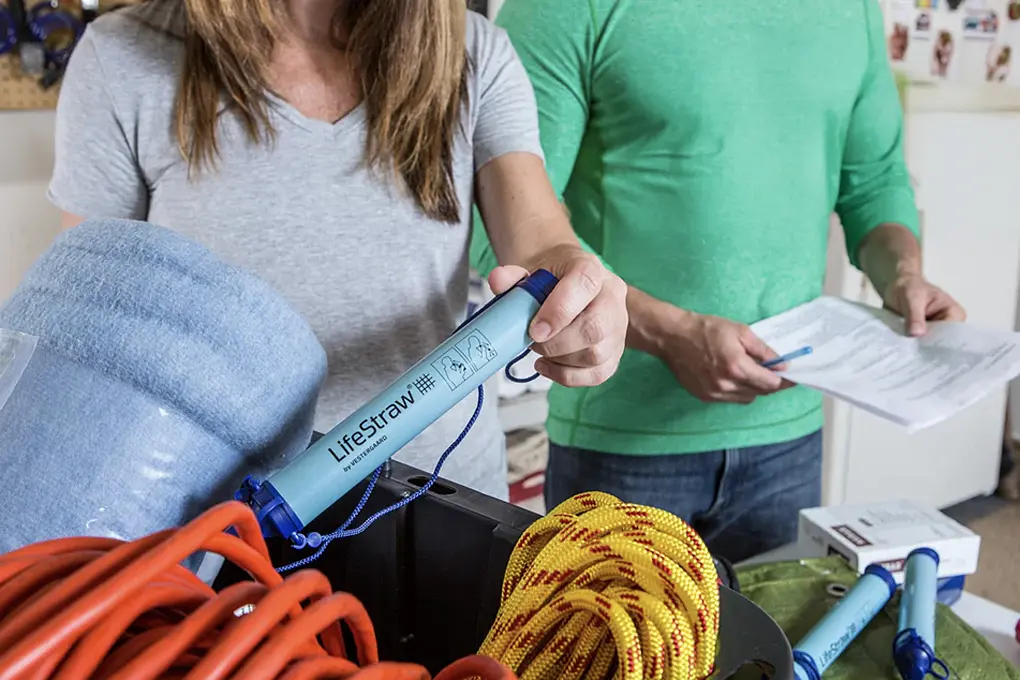Quick Answer: Emergency preparedness for beginners means building a 72-hour supply kit, creating a family communication plan, and preparing your home for power or water loss. This guide explains how to start small, avoid common mistakes, and build lasting safety for your family using Batten’s proven preparedness system.
If a recent storm, blackout, or supply shortage made you realize how unprepared your household really is, you’re already ahead of most. Knowing you need a plan is the first step – and this guide on emergency preparedness for beginners will show you exactly how to create one that actually works.
Forget the extremes of doing nothing or turning your home into a bunker. Batten Emergency focuses on realistic, family-friendly preparedness that fits your lifestyle and budget. You’ll learn how to build practical kits, organize essential supplies, and create a plan that keeps everyone safe when it matters most.
Table of Contents
- Key Takeaways
- Why Every Family Needs Emergency Preparedness in 2025
- The 72-Hour Rule: Why Three Days Changes Everything
- Building Your First 72-Hour Emergency Kit
- Creating Your Family Emergency Plan
- Home Preparedness: Turning Your House into a Refuge
- Bug-Out Preparedness: Rapid Evacuation Readiness
- Budget-Friendly Prepping: Building Readiness Without Breaking Banks
- Common Prepping Mistakes That Waste Time and Money
- Maintaining Your Emergency Supplies
- Prepping for Beginners with Batten
- Frequently Asked Questions
- Sources
Key Takeaways
- The 72-hour rule simplifies readiness into three stages: surviving the first three days, managing extended disruptions up to four weeks, and building long-term resilience with renewable systems.
- A well-balanced 72-hour kit includes water (one gallon per person per day), ready-to-eat food, first aid, power and lighting, shelter, and critical documents stored safely.
- Family emergency plans should cover layered communication systems, pre-determined meeting points, and clear evacuation routes that everyone practices regularly.
- Home preparedness focuses on power, water, and cooking alternatives that keep your household safe and comfortable during extended utility failures.
- Start building your readiness today with Batten Emergency’s step-by-step guides, curated survival kits, and family planning tools designed to make real-world preparedness achievable for every home.
Why Every Family Needs Emergency Preparedness in 2025
Emergencies are no longer rare events – they’re a constant part of life in the United States. In 2024 alone, FEMA declared 90 major disasters, almost double the 30-year average of 55. That means a new disaster hit every four days. Nearly 137 million Americans – about 41% of the population – lived in areas affected by either a major disaster or emergency declaration at some point during the year.
Power outages now affect one in four U.S. households annually, and 70% of those outages last six hours or more. Hurricanes Helene and Milton left millions without power for weeks, exposing just how fragile everyday systems have become. For most families, these disruptions bring more than inconvenience – they create real financial and safety risks.
When unprepared families evacuate, they spend an average of $200 to $500 per day on hotels, food, and emergency supplies. Those with basic preparedness plans avoid these costs entirely. Research shows that prepared households recover faster, experience less stress, and are better positioned to help their neighbors during local crises.
Yet most Americans remain underprepared. A 2025 Talker Research survey found that while 90% of adults believe it’s critical to be ready for disasters, only 46% actually have a plan. Just 26% own a backup generator, and less than a third have extra gasoline, printed maps, or pet supplies ready. Despite the growing threat, more than half of respondents still believe they’re less likely than others to be impacted by extreme weather.
Your biggest obstacles to starting likely include:
- Information Overload: conflicting advice from doomsday preppers versus vague government checklists.
- Cost Concerns: assuming preparedness requires thousands of dollars upfront.
- Time Constraints: thinking planning will consume your weekends.
- Storage Limitations: especially in apartments or small homes.
- Family Resistance: loved ones dismissing your efforts as unnecessary.
Batten Emergency’s approach solves these barriers through graduated preparation systems, expert-vetted gear recommendations eliminating guesswork, and practical guides for real families, not survivalist fantasies.
The 72-Hour Rule: Why Three Days Changes Everything
Preparing for every possible disaster at once often leads to inaction. The 72-hour rule simplifies emergency preparedness by breaking it into three focused stages, each building toward long-term stability.
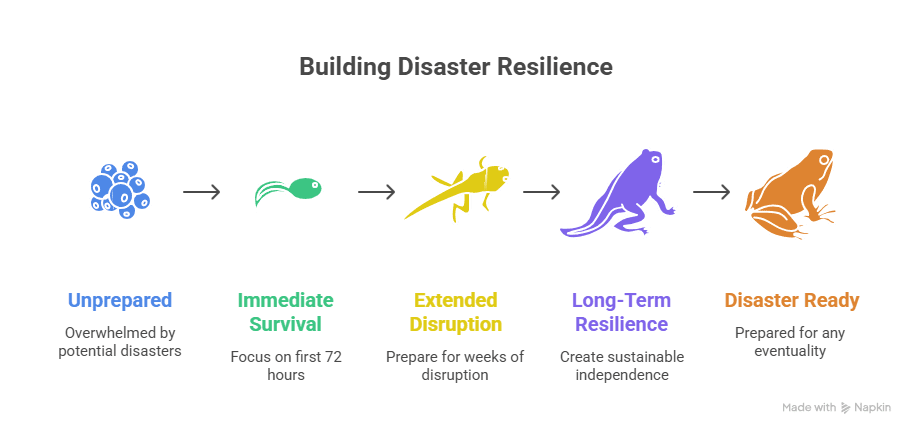
Immediate Survival (0-72 Hours)
The first three days after a disaster are critical. Power fails, stores close, and emergency services are stretched thin. Families with 72-hour kits during events like Hurricane Katrina stayed safe while others waited days for help. Keep it simple – water, food, warmth, light, first aid, and communication tools that require no setup.
Extended Disruption (1-4 Weeks)
Modern disasters often last beyond the first few days. The 2021 Texas freeze left millions without power for over a week, and COVID-19 caused weeks of shortages. Expand your supplies with more food, water filters, cooking gear, sanitation essentials, and basic entertainment. Include cash and key documents to stay functional when systems fail.
Long-Term Resilience (1+ Months)
Once short-term needs are covered, focus on sustainability. Solar generators, rainwater systems, and small gardens create renewable independence. While beginners can start small, understanding this phase helps you plan for lasting security rather than short-term survival.
Building Your First 72-Hour Emergency Kit
A 72-hour kit is the foundation of practical emergency preparedness. Batten Emergency’s curated survival kits simplify the process, but understanding each category helps you customize it for your family’s unique needs.
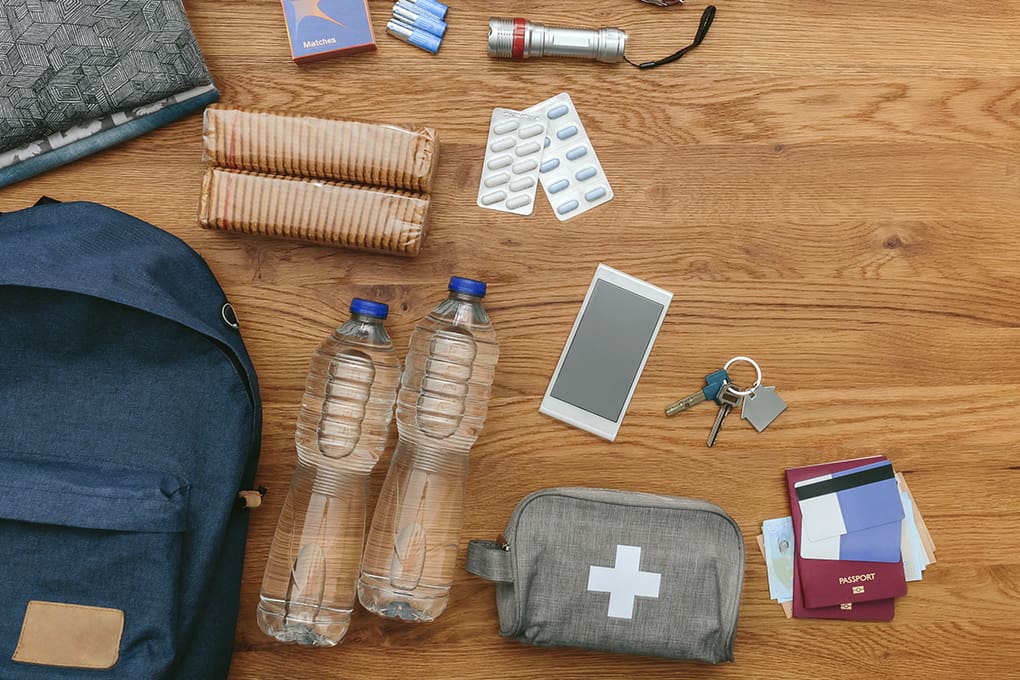
Water: The Foundation of Survival
Dehydration becomes life-threatening within three days. Store at least one gallon per person per day – 12 gallons for a family of four. Avoid milk jugs that degrade quickly, and don’t store water in garages where temperature swings cause bacterial growth.
Add eight drops of unscented bleach per gallon for long-term storage, and include purification tablets or portable filters like LifeStraw for contamination scenarios. Rotate stored water every six months to maintain safety.
Food: Calories Without Cooking
When power or gas fail, cooking becomes impossible. Focus on ready-to-eat foods providing about 2,000 calories per person daily.
Smart No-Cook Options
- Proteins: Peanut butter, canned tuna or chicken, protein bars
- Carbohydrates: Crackers, granola, instant oatmeal
- Comfort Items: Chocolate, instant coffee, and familiar snacks to boost morale
- Special Needs: Baby formula, pet food, or dietary-specific item
Batten’s long-term food kits last up to 25 years, but beginners should start with shelf-stable, easy-to-eat foods before moving to freeze-dried options.
First Aid: Beyond Basic Bandages
Disasters often cut off medical access, so your kit should cover both trauma and everyday health needs.
Critical Supplies
- Prescription medications (minimum 30-day reserve)
- Tourniquet and hemostatic gauze for severe bleeding
- Spare eyeglasses or contacts
- Feminine hygiene and infant care supplie
During Hurricane Sandy, power outages left diabetics without insulin for days. Ask your doctor for emergency prescriptions and review your kit every six months to replace expired items.
Power and Light: Staying Informed and Connected
Average outages last about six hours, but storms can leave millions without power for days. A solid power plan keeps your home functional.
Essential Items
- LED flashlights and headlamps for each person
- Power banks (minimum 20,000mAh per person)
- Hand-crank or battery-powered NOAA radio
- Solar panels or generators for extended outages
- Candles and matches as non-electric backup
Families with power banks during California’s grid shutoffs maintained communication and safety while others were isolated.
Tools and Supplies: Everyday Gear That Saves the Day
Reliable tools turn chaos into control.
Multi-Use Essentials
- Multi-tool or Swiss Army knife
- Duct tape and contractor bags
- Zip ties and work gloves
- Small shovel for waste or shelter setup
- Whistle, toilet paper, zip-top bags, and permanent marker
Power loss increases fire risk, so include a compact fire extinguisher. Batten’s tactical gear kits include pre-tested tools for emergency reliability.
Shelter and Warmth: Protecting Against Exposure
Cold exposure can kill within hours. Even if you stay home, your heating systems may fail.
Shelter Items
- Mylar emergency blankets
- Sleeping bags suited to your local climate
- Tarps and plastic sheeting for quick repairs
- Duct tape and zip ties to secure makeshift shelters
- Warm layers and rain gear for all seasons
Documents: Proof When Systems Collapse
Essential documents confirm your identity, property, and access to aid. Keep both paper and encrypted digital copies in waterproof storage.
Include
- IDs, passports, birth certificates, and insurance policies
- Medical records, prescriptions, and property deeds
- Bank and credit information
- Family and pet photos for identification
- $200-$500 cash in small bills
In displacement or evacuation, these records prevent bureaucratic delays and restore normalcy faster.
Creating Your Family Emergency Plan
Supplies alone don’t create safety. A strong family plan turns stored gear into real protection by outlining exactly what to do when disaster strikes.
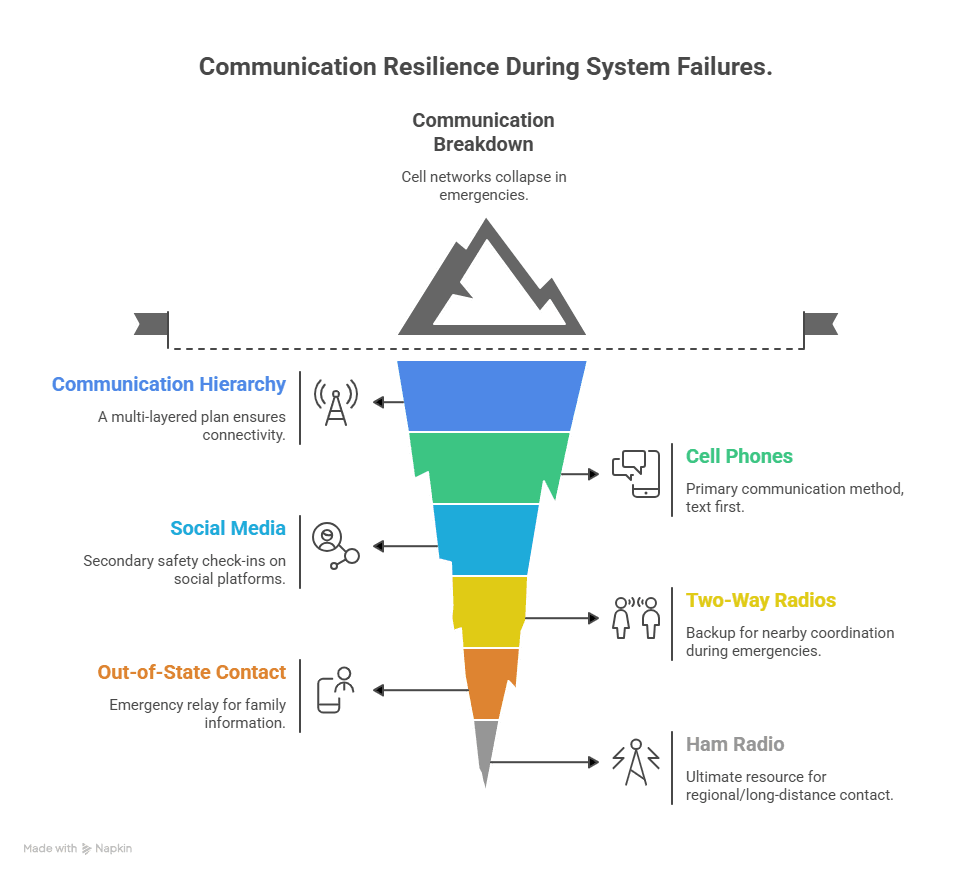
Communication When Systems Fail
Cell networks collapse quickly in emergencies, leaving families unable to reach one another. A reliable plan uses multiple communication layers to stay connected.
Communication Hierarchy
- Primary: Cell phones – text first to save bandwidth
- Secondary: Social media safety check-ins (e.g., Facebook Safety Check)
- Backup: Two-way radios for nearby coordination
- Emergency: Out-of-state contact who relays information between family members
- Ultimate: Ham radio for regional or long-distance contact
Store emergency contacts in every phone and keep written copies in wallets and kits – technology only helps if it works. Batten’s communication guides include detailed instructions for radio setup and signal use.
Meeting Points and Evacuation Routes
Pre-established meeting points prevent panic during chaos. Set three locations for different scales of emergency.
Meeting Location Hierarchy
- Immediate: Front yard or nearby safe spot for house fires (within one minute)
- Neighborhood: School or park within five minutes of home for local incidents
- Regional: Relative’s home or safe zone in another city for large-scale evacuations
Plan multiple escape routes from home, work, and schools. In California wildfires, families familiar with alternate routes escaped when highways closed. Keep printed maps since GPS often fails when cell service drops. Mark critical stops – gas stations, hospitals, and pet-friendly shelters – and rehearse routes during both peak and off-peak hours to understand real travel times.
Emergency-Specific Action Plans
Generic plans fail because different emergencies require opposite responses. Create scenario cards for regional threats:
| Emergency Type | Initial Response | Safe Location | Time to Act | Key Supplies |
| House Fire | Evacuate immediately | Outside meeting point | 30 seconds | Nothing – just leave |
| Tornado | Take shelter | Interior room, lowest floor | 1-3 minutes | Helmets, blankets |
| Earthquake | Drop, cover, hold | Under sturdy furniture | Immediate | First aid, tools |
| Hurricane | Evacuate or shelter | Depends on category | 24-48 hours | All supplies |
| Power Outage | Assess and adapt | Stay home | Hours | Generator, lights |
| Chemical Spill | Evacuate crosswind | Upwind location | 5-15 minutes | Go-bags, radio |
Document medical needs, prescriptions, and dietary restrictions. During Hurricane Irma, dialysis patients who’d mapped alternate facilities accessed life-saving treatment while others couldn’t. Batten’s family planning resources help create age-appropriate emergency plans.
Home Preparedness: Turning Your House into a Refuge
Most disasters keep you at home without power or running water rather than forcing evacuation. Preparing your home as a self-sufficient refuge increases comfort, safety, and survival during long disruptions.
Power Outage Survival Strategy
Power failures are the most common emergency, affecting one in four U.S. households each year. A layered backup plan keeps you functional through each phase.
Layered Power Plan
- Hours 1-6: Use flashlights, candles, and fully charged phones
- Hours 6-24: Switch to power banks and battery radios for news
- Days 1-3: Rely on solar chargers or portable generators for essentials
- Beyond 3 days: Maintain fuel reserves and adjust to reduced power use
For winter, close unused rooms, seal windows, and wear layered clothing before using space heaters. In summer, use battery fans, damp towels, and move to the coolest room, usually north-facing or in the basement. Keep non-electric entertainment – board games, books, and crafts – since stress and boredom often rise faster than real danger.
Water System Backup Plans
Water systems often fail during disasters even when plumbing remains intact. Beyond bottled water, identify secondary household sources.
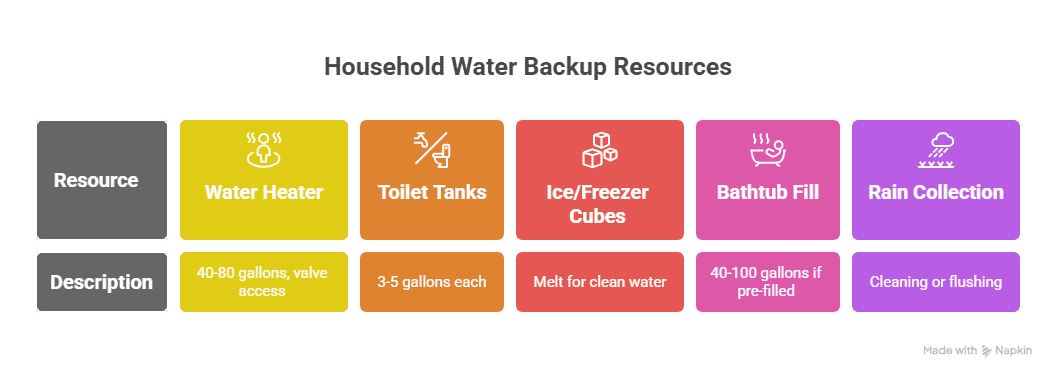
Household Water Resources
- Water Heater: 40-80 gallons, accessible through the drain valve
- Toilet Tanks (not bowls): 3-5 gallons each
- Ice and Freezer Cubes: melt for clean water
- Bathtub Fill: 40-100 gallons if filled before shutdowns
- Rain Collection: usable for cleaning or flushing
Locate your home’s shutoff valve to prevent contamination during boil advisories. Fill bathtubs and large containers at the first warning – gray water is ideal for sanitation once drinking supplies run low. Batten’s water storage guide details purification methods for questionable sources.
Alternative Cooking Without Power
Cooking becomes difficult when gas and electricity fail, so multiple fuel options keep meals possible.
Emergency Cooking Methods
- No Fuel: Solar ovens, thermal cooking bags, or ready-to-eat meals
- Low Fuel: Alcohol stoves, candle warmers, or car engine heat
- Standard Fuel: Propane camp stoves, charcoal grills (outdoor only), or wood fires
- Extended Use: Solar generators powering electric cooktops
Never use grills or fuel-burning stoves indoors since carbon monoxide buildup can be fatal. During extended outages, coordinate with neighbors to share fuel and equipment – community cooking saves resources and boosts morale.
Bug-Out Preparedness: Rapid Evacuation Readiness
While 90% of emergencies involve staying home, certain scenarios demand immediate departure. Wildfire evacuations provide 15 minutes warning. Chemical spills require instant evacuation. Your bug-out preparations enable five-minute departure.
The 5-Minute Evacuation System
Structure bug-out supplies by time available:
Evacuation Priority Timeline
- 0-30 Seconds: Lives (people and pets)
- 30 Seconds-2 minutes: Bug-out bags and documents
- 2-5 Minutes: Additional supplies and comfort items
- 5-15 Minutes: Extended supplies if time permits
Pre-position bags near exits, not buried in closets. Include “get-home bags” at work with walking shoes, water, snacks, and maps. Vehicle kits remain in cars year-round. Keep a “treasure box” of irreplaceable items (photos, heirlooms) ready to grab. Batten’s bug-out planning guide details rapid evacuation strategies.
Vehicle Emergency Readiness
Your vehicle becomes life support during evacuation. Maintain half-tank minimum always – gas stations fail immediately without power, and evacuation creates massive lines at functioning pumps.
Vehicle Emergency Kit Essentials
| Category | Items | Purpose |
| Mechanical | Jumper cables, tire repair kit, tow straps | Vehicle recovery |
| Navigation | Paper maps, compass, GPS device | Multiple routing options |
| Survival | Water, food, blankets, first aid | Extended travel delays |
| Communication | Car charger, emergency radio | Information and coordination |
| Financial | Cash, coins for tolls | Electronic payment failure |
| Seasonal | Ice scraper, sun shade, rain gear | Weather-specific needs |
During Hurricane Rita, families ran out of gas in gridlocked traffic. Store extra fuel safely, rotating every six months. Back vehicles into driveways for faster departure. Keep written evacuation checklists – panic impairs memory and judgment.
Budget-Friendly Prepping: Building Readiness Without Breaking Banks
The myth that preparedness requires thousands upfront prevents families from starting. Strategic building creates comprehensive readiness while spreading costs.
The $20-30 Weekly System
Dedicate weekly grocery money to rotating preparedness categories:
Weekly Shopping Rotation
- Week 1: Water storage (two 5-gallon containers)
- Week 2: Canned proteins and shelf-stable foods
- Week 3: Batteries, flashlights, and candles
- Week 4: First aid and hygiene supplies
This builds substantial preparedness within 3-6 months without financial strain. Watch for sales on non-perishables, buying extra when prices drop.
Free Preparation Resources
Skills trump gear during emergencies.
Zero-Cost Training Opportunities
- YouTube tutorials (first aid, repairs, radio operation)
- CERT (Community Emergency Response Team) training
- Red Cross first aid/CPR certification events
- Amateur radio club licensing preparation
- Library books on preparedness and survival
- Batten Emergency’s free guides
Practice costs nothing but builds muscle memory: monthly fire drills, alternative cooking experiments, map navigation exercises, and power-free weekends testing backup systems. Knowledge becomes permanent personal infrastructure while gear eventually fails.
Common Prepping Mistakes That Waste Time and Money
Learning from others’ failures accelerates success while avoiding costly errors.
Buying Without Practicing
Expensive equipment becomes dangerous liability without practice. Your generator won’t start if you’ve never run it. Water filters fail if you don’t know proper operation. First aid supplies can’t help if you lack training.
Quarterly Practice Schedule
- Spring: Severe weather response and evacuation routes
- Summer: Water purification and outdoor cooking
- Fall: Generator operation and winter preparation
- Winter: Power outage simulation and supply rotation
Solo Prepping Without Family Buy-In
Perfect preparations fail if your spouse doesn’t know where supplies are stored or teenagers can’t operate emergency equipment. Include everyone in planning and practice.
Family Engagement Strategies
- Frame as camping skills or self-reliance education
- Make preparation fun with emergency cooking competitions
- Let kids pack their own comfort items
- Practice with rewards (pizza after successful fire drill)
- Share age-appropriate information without fear-mongering
Children participating in emergency planning show less anxiety during actual events. Regular family meetings ensure everyone understands their role when stress impairs thinking.
Maintaining Your Emergency Supplies
Static supplies degrade into useless clutter. Sustainable maintenance ensures readiness when needed.
Quarterly Maintenance Schedule
Align reviews with seasonal changes:
Seasonal Prep Review Calendar
- March (Spring): Tornado/hurricane preparation, prescription updates
- June (Summer): Evacuation route verification, vehicle supply check
- September (Fall): Winter preparation, battery replacement
- December (Winter): Annual inventory, insurance review
During each review: check expiration dates, test all equipment, update documents and contacts, and verify family plan understanding. Use smartphone reminders for maintenance tasks.
Food Rotation System
Prevent waste through “first in, first out” rotation:
- Mark purchase dates clearly on items
- Use older supplies for regular meals
- Immediately replace consumed items
- Integrate emergency food into meal planning
Create inventory sheets tracking supplies, quantities, locations, and expiration dates. Many smartphone apps automate reminder notifications. Batten’s food storage guide explains extended preservation techniques.
Prepping for Beginners with Batten
True preparedness doesn’t mean living in fear – it means giving your family a plan when life’s routines suddenly stop working. From 72-hour survival kits to home power backup and evacuation routes, each small step builds lasting resilience. Start where you are, add what you can, and practice until every family member knows their role. Emergencies may be unpredictable, but your response doesn’t have to be.
Get started today with Batten Emergency’s expert-vetted guides and gear – everything you need to keep your household ready, calm, and confident when it matters most.
Frequently Asked Questions
How Much Water Should I Store for a Family of Four for Two Weeks?
Store 56 gallons minimum for a family of four (1 gallon per person per day for 14 days), using food-grade containers or water barrels with rotation every six months. Consider additional water for pets, cooking, and hygiene beyond drinking needs. The Batten Emergency water storage guide provides detailed preservation and purification methods for long-term storage.
What’s the Difference Between Bugging in and Bugging Out in Prepping Terms?
Bugging in means sheltering at home during emergencies with adequate supplies for extended utility failures, while bugging out involves evacuating to a safer location with portable supplies. Most emergencies (90%) involve bugging in, but having bug-out bags ready ensures you can evacuate within minutes if conditions become dangerous. Prepare for both scenarios with dedicated supplies and plans.
How Can I Prepare for Emergencies if I Live In an Apartment With Limited Storage?
Apartment preppers succeed by maximizing vertical storage with shelving, using under-bed containers for water and food storage, keeping bug-out bags in coat closets near exits, and storing supplies in temperature-stable interior closets rather than balconies. Focus on compact, multi-use items and coordinate with neighbors for community preparedness. The urban emergency preparation guide addresses space-limited preparation strategies.
Should Beginners Buy Pre-Made Emergency Kits or Build Their Own?
Pre-made emergency kits from Batten’s curated collection provide immediate baseline preparedness with quality-tested supplies, ideal for beginners wanting instant readiness. However, building your own kit teaches valuable skills, allows customization for specific needs (prescriptions, dietary restrictions, climate), and often costs less. Many preppers recommend starting with a basic pre-made kit then expanding with customized additions.
How Do I Prepare My Kids for Emergencies Without Scaring Them?
Frame emergency preparedness as family camping adventures or life skills education, involving children in age-appropriate tasks like packing their own emergency comfort items. Practice fire drills as games with rewards, read books about community helpers and safety, and emphasize preparation makes families strong rather than focusing on scary scenarios. Family emergency planning resources offer child-friendly approaches to building confidence instead of fear.
What’s the Most Important Prep Item if I Can Only Afford One Thing?
Water storage or purification represents the single most critical preparedness investment since humans survive only 3 days without water. A quality water filter like LifeStraw ($20) or water purification tablets ($10) provide thousands of gallons of safe drinking water from questionable sources. After water, focus on light (flashlight and batteries) and first aid supplies for immediate impact preparedness.
How Often Should I Update My Emergency Supplies and Plans?
Review emergency plans quarterly with family discussions, rotate food and water supplies every six months, check batteries and test equipment seasonally, update important documents annually or after major life changes, and conduct practice drills twice yearly (spring and fall). Set smartphone reminders for maintenance tasks ensuring your preparedness remains current and functional. The seasonal emergency kit update guide provides detailed maintenance schedules.
Sources
- International Institute for Environment and Development (IIED). 2025. Major Disaster in the US Declared Every Four Days in 2024, IIED Analysis Shows. Major disaster in the US declared every four days in 2024, IIED analysis shows | International Institute for Environment and Development
- United States Census Bureau. 2024. How Do Power Outages Affect Households? How Do Power Outages Affect Households?
-
New York Post. 2025. Americans Least Prepared for Natural Disasters Are Baby Boomers, Survey Shows. Boomers are least prepared Americans for natural disasters, new survey shows
- Energy Research & Social Science. 2021. Cascading risks: Understanding the 2021 winter blackout in Texas. Cascading risks: Understanding the 2021 winter blackout in Texas – ScienceDirect
- U.S. Energy Information Administration. 2024. U.S. Electricity Customers Averaged Five and One-Half Hours of Power Interruptions in 2022. U.S. electricity customers averaged five and one-half hours of power interruptions in 2022 – U.S. Energy Information Administration (EIA)
